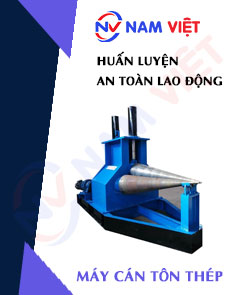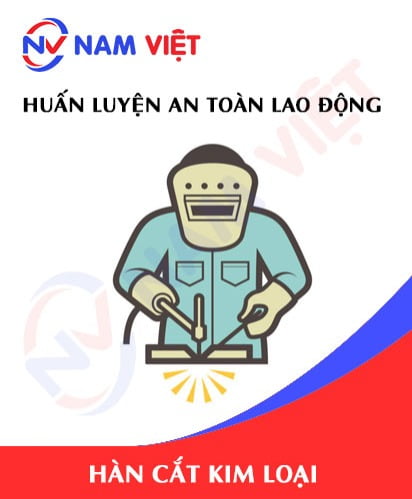Occupational Safety Training for Operating Steel Sheet Rolling Machines
99,000 ₫
Note: The above price is calculated for one person and may fluctuate depending on the number of participants in the course and market conditions. For more accurate pricing support, please refer to the price list or contact our consulting staff directly.
Occupational safety is an important issue when operating the Steel Sheet Rolling Machine and needs to be addressed promptly to ensure the health and safety of workers and to enhance the reputation of businesses here. The Occupational Safety Training course is one of the effective solutions to raise awareness of how to prevent workplace accidents for workers operating the Steel Sheet Rolling Machine.
Table of Contents
Toggle1. Overview of Steel Sheet Rolling Machine
a. What is a Steel Sheet Rolling Machine?
A Steel Sheet Rolling Machine is an industrial device used to transform the shape of steel sheets. This rolling process is typically performed to create products with specific shapes and sizes, such as steel sheets, steel pipes, or other structural components.
The operating principle of a steel sheet rolling machine usually involves placing a steel sheet between two rollers and applying compressive force to change its thickness and shape. This process can be repeated multiple times with specific settings to achieve the desired result. Rolling machines can be adjusted to form steel into different shapes, depending on production requirements.
Applications of steel sheet rolling machines are diverse and may include the production of construction structural components, shipbuilding, automotive manufacturing, and many other industrial fields.

b. Operating Principle of Steel Sheet Rolling Machine
The operating principle of a steel sheet rolling machine involves applying compressive force to a steel sheet to change its thickness and shape. Below is an overview of how the machine operates:
- Placing the steel sheet: A steel sheet is positioned between the two rollers of the machine.
- Compressive force: The upper and lower rollers apply pressure, generating high force on the steel sheet. This force is adjusted to meet specific rolling requirements.
- Shape transformation: The compressive force deforms the steel sheet and reduces its thickness. If necessary, the process can be repeated multiple times with varying pressure to achieve the desired result.
- Rolling stages: Rolling machines often have multiple stages, with each stage using a different pair of rollers to refine the steel sheet’s shape.
- Control system: The rolling process is typically managed by automated systems to ensure accuracy and uniformity of the final product.

c. Industries Using Steel Sheet Rolling Machines
Steel sheet rolling machines are widely used across various industries to produce steel products in different shapes and sizes. Some major industries using these machines include:
- Construction: Used to produce steel sheets and structural components such as columns, beams, and other construction elements.
- Shipbuilding: Used to manufacture parts of ship hulls, containers, and other structural components.
- Automotive: Plays an important role in producing car panels, frames, and other automotive components.
- Energy: Used to produce steel pipes and components for oil, gas, and renewable energy industries.
- Machinery and Equipment Manufacturing: Used to produce parts for industrial machinery and equipment.
- Processing Industry: Used in various manufacturing processes, such as producing household appliances and other required components.
2. Overview of Occupational Safety Training for Operating Steel Sheet Rolling Machines
a. What is Occupational Safety Training?
- Occupational safety training for operating steel sheet rolling machines provides workers with awareness on preventing workplace accidents. Workers directly operating these machines belong to Group 3.
- The safety training course helps workers identify and prevent hazards, reducing the risk of workplace accidents.
REGISTER FOR OCCUPATIONAL SAFETY TRAINING SERVICE
b. Training Duration
Initial safety training duration:
- Total training time is at least 24 hours, including testing time.
- 8 hours of theory on safety and labor hygiene policies and laws
- 8 hours of theory on basic occupational safety and hygiene knowledge
- 4 hours of theory on specialized training content
- 2 hours of practical training on specialized content
- 2 hours of theory test at the end of the course
The training center schedules sessions depending on workers’ availability, typically in 6 sessions over 3 days, provided the company arranges continuous training time.
Periodic safety training duration:
- Before the occupational safety card expires, workers must undergo periodic occupational safety training, with the duration being at least 50% of the initial training time.
Explanation: total periodic safety training time is at least 12 hours, including testing. After completing the course and passing the test, workers are reissued and renewed their occupational safety card.
c. Course Content
| No. | TRAINING CONTENT | TRAINING TIME (HOURS) | |||
| Total | Including | ||||
| Theory | Practice | Test | |||
| I | System of policies and laws on occupational safety and hygiene | 8 | 8 | 0 | 0 |
| 1 | Overview of the legal framework on occupational safety and hygiene. | 6 | 6 | ||
| 2 | Standards and technical regulations on occupational safety and hygiene. | 1 | 1 | ||
| 3 | Specific regulations from government authorities regarding occupational safety when constructing, expanding, or renovating facilities for production, use, storage, inspection of machines, equipment, materials, and substances with strict safety requirements. | 1 | 1 | ||
| II | Basic knowledge of occupational safety and hygiene | 8 | 8 | 0 | 0 |
| 1 | Basic knowledge of workplace hazards and harmful factors. | 4 | 4 | ||
| 2 | Methods to improve working conditions. | 1 | 1 | ||
| 3 | Safety culture in production and business. | 1 | 1 | ||
| 4 | Rights and obligations of employers and employees; safety policies for employees; functions of safety networks and safety officers. | 1 | 1 | ||
| 5 | Safety rules, signage, use of safety equipment and personal protective equipment; first aid skills for accidents and occupational disease prevention. | 1 | 1 | ||
| III | Specialized training content | 6 | 4 | 2 | 0 |
| Comprehensive knowledge of machines, equipment, substances causing hazards; risk analysis, management, and safe working procedures for machines, equipment, and hazardous substances. | 6 | 4 | 2 | ||
| IV | Final training test | 2 | 2 | 0 | 0 |
| Total | 24 | 22 | 2 | ||
See more training content of 6 groups
d. Occupational Safety Card
After completing the training course and passing the test, workers will be issued a Occupational Safety Card (commonly referred to as Group 3 Safety Certificate).
The Group 3 safety card displays information such as full name, date of birth, specific job and work environment, training duration, official stamp, and signature confirming course completion.
According to regulations in Clause 2, Article 24 of Decree 44/2016/ND-CP, there are two cases:
- If the employer and employee have a labor contract, the employer must sign and stamp the safety card for Group 3 employees after they complete the training and pass the test.
- If the worker is freelance or seasonal with no labor contract, the training unit must sign and stamp the safety card after the worker completes the training and passes the test.

3. Hazards When Operating Steel Sheet Rolling Machines
Operating steel sheet rolling machines can involve numerous hazards due to the nature of the work and the working environment. Below are some common hazards when operating steel sheet rolling machines:
- Injuries from machinery: Moving parts of the rolling machine, such as rollers and transmission systems, can pose injury risks if workers do not follow safety rules or are not properly trained.
- Heat hazards: The rolling process often generates high temperatures. Uncontrolled heat can cause fire or explosions or degrade machine components.
- Crushing and deformation hazards: Rolling machines can produce high pressure, and without proper safety measures, workers risk being crushed, deformed between rollers, or trapped in machine parts.
- Chemical hazards: Coating and surface treatment processes may use toxic chemicals, posing health risks if safety measures are not followed.
- Noise and vibration hazards: Rolling machines generate noise and vibrations that can affect workers’ health if ear protection and anti-vibration equipment are not used.
- Fire hazards: High temperatures and work processes can increase fire risks. Maintaining fire prevention and emergency measures is crucial.
- Lack of safety training and awareness: High risk occurs when employees are not properly trained in workplace safety and machine operation procedures.

4. Measures to Control Workplace Accidents When Operating Steel Sheet Rolling Machines
To control workplace accidents when operating steel sheet rolling machines, several safety measures must be implemented. Here are some important measures:
- Training and Instructions:
- All employees working with rolling machines must be fully trained on occupational safety and machine operation procedures.
- Provide clear instructions on specific safety measures related to steel sheet rolling machines.
- Use of Personal Protective Equipment (PPE):
- Require employees to use PPE, including safety glasses, helmets, gloves, and safety shoes.
- Ensure PPE is regularly inspected and replaced when necessary.
- Regular Inspection and Maintenance:
- Conduct regular inspections and maintenance to ensure the machine operates correctly and safely.
- Set up a schedule for periodic maintenance and servicing of mechanical and electrical systems.
- Workplace Monitoring:
- Implement a monitoring system to track work processes and detect safety issues early.
- Perform regular safety inspections and risk assessments on site.
- Temperature Control:
- Ensure work processes do not produce excessive heat, causing fire risks or reducing machine durability.
- Alarm Systems and Quick Response:
- Install alarm systems to alert about safety issues immediately.
- Develop quick response plans and train employees on emergency procedures.
- Compliance with Industrial Safety Rules:
- Ensure all workers follow specific safety rules of the industry and company.
- Noise and Vibration Control:
- Provide ear protection and anti-vibration equipment to minimize the effects of noise and vibration on workers.
5. Benefits of Occupational Safety Training
An Toàn Nam Việt offers businesses the following benefits after completing occupational safety training courses as regulated in Decree 44/2016/ND – CP on occupational health and safety. Companies and enterprises will benefit as follows:
- Employees can identify potential workplace hazards and take preventive measures to avoid accidents.
- Businesses can implement risk prevention measures in production, operation, and maintenance processes.
- Reduce costs associated with workplace safety incidents.
- Continuous production increases productivity and product quality.
- Ensure compliance with labor safety laws, avoiding legal risks.
- Enhance company credibility and professionalism, elevating brand reputation.
Nam Việt’s training programs help prevent external factors from harming individuals, enabling them to avoid injuries or worse, fatalities.
REGISTER FOR OCCUPATIONAL SAFETY TRAINING SERVICES
6. Customer Feedback After Completing Training
An Toàn Nam Việt has years of experience supporting businesses across Vietnam, especially in the southern provinces. This responsibility is highly valued, which is why our Occupational Safety Training is increasingly professional. The motivation for our growth comes from positive feedback and constructive suggestions from our corporate partners. Below are testimonials from our clients.
See more customer interviews after using the service from An Toàn Nam Việt
7. Occupational Safety Training Capacity of An Toàn Nam Việt
An Toàn Nam Việt is a reputable and quality occupational safety training center in Vietnam. Training sessions are continuously conducted at factories, production workshops, or construction sites nationwide (all 63 provinces).
REGISTER FOR OCCUPATIONAL SAFETY TRAINING SERVICES
Occupational Safety Training License
- An Toàn Nam Việt has been inspected and certified by the Department of Safety, Ministry of Labor, Invalids, and Social Affairs for the conditions to operate occupational safety and hygiene training, further strengthening our training capacity.

Training Materials and Lectures
- Before being used in OST courses, training materials are reviewed to ensure accuracy and effectiveness.
- Lecturing methods follow An Toàn Nam Việt standards, researched and refined by occupational safety training experts to maximize knowledge retention for trainees.
Facilities
- Controlling classroom conditions enhances teaching efficiency and knowledge absorption.
- Our training facilities offer spacious classrooms with proper lighting and equipment for effective training.
8. Nationwide Reputable Occupational Safety Training Center
At An Toàn Nam Việt, we prioritize professional dedication to occupational safety training. Our mission is to equip workers with self-protection knowledge, contributing to national development.
For effective training, we meticulously prepare every detail, including tools, teaching equipment, curriculum, materials, sound, and lighting.
Our instructors are experts with years of experience and research in hazard identification and prevention across industries.
Lectures are practical, engaging, and easy for workers to understand, always aligned with Decree 44/2016/ND-CP.
This equips trainees with hazard prevention measures and self-protection skills applicable in real work situations.
Our training center proudly offers professional and reputable occupational safety training with these advantages:
- Competitive training costs without compromising quality.
- Flexible training schedules aligned with company production.
- Quick, legally compliant certification procedures.
- Experienced instructors.
- Classrooms optimized for teaching efficiency and knowledge absorption.
- Lectures tailored to enterprise occupational safety needs.
- Dedicated and professional support for clients promptly and accurately.

9. Additional Occupational Safety Training Materials
10. Occupational Safety Training Activities
1 review for Occupational Safety Training for Operating Steel Sheet Rolling Machines
No comments yet















phanminhhang341
Giảng viên dạy rất sinh động dễ hiểu!